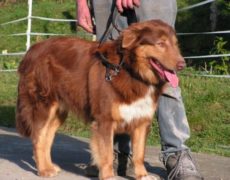Aidi
The Aidi, with its beautiful round dark eyes above its tapering snout and a bushy plume tail, is a fiercely loyal but benign dog. This muscular yet lean Moroccan breed has slightly droopy ears along with a dark nose that generally matches the color of the coat.
Aidi Pictures
- Aidi Dog
- Aidi Images
- Aidi Photos
- Aidi Pictures
- Aidi
- Atlas Mountain Dog
- Atlas Mountain Hound
- Atlas Shepherd Dog
- Images of Aidi
- Kabyle Dog
- Pictures of Aidi
- Aidi Puppies
Quick Information
| Other Names | Chien de l’Atlas, Chien de Montagne de l’Atlas, Atlas Mountain Dog, Atlas Shepherd Dog, Kabyle Dog, Berber Dog, Atlas-Schäferhund, Aïdi, Atlas Mountain Hound, Atlas Sheepdog |
| Coat | Coarse, heavy, protective double coat with soft undercoat and longer, wiry top coat |
| Color | White, black, black and white, pale red, tawny, fawn, brown |
| Type | Purebred |
| Group | Working Dog, Livestock Guardian, Molossers, Mountain Dog |
| Lifespan | 10-12 years |
| Size | Medium |
| Height | 21-24 inches |
| Weight | Approximately 55lbs |
| Litter Size | 5-8 puppies |
| Temperament | Protective, loyal, loving, energetic, alert, sensitive |
| Good with Children | Yes |
| Good with Other Pets | Only with proper socialization |
| Climate Compatibility | High |
| Barking | Medium to high |
| Shedding | Average with heavy shedding once a year |
| Hypoallergenic | No |
| Competitive Registration Qualification/ Information | UKC, FCI, DRA, ACA |
| Country | Morocco |
Aidi Dog Video
History
The origins of the Aidi, whose roots probably lie in North Africa, can be traced back to the Sahara region. Developed in the Atlas Mountains of Morocco, Libya, and Algeria primarily as a livestock guardian, it was also bred to defend and protect its handlers against various predators like jackals and wildcats.
The breed is also known as Berber, alluding to the Berber tribe who once used it to protect themselves and guard their belongings. It bears a striking resemblance to the Pariah dog with the two breeds probably sharing ancestry.
However, it is also believed by many that the breed was developed by the industrious Phoenicians of the Mediterranean coast, who happened to be professional dog breeders.
Recently, Moroccans even formed an organization dedicated to the protection of the purity of this breed.
Despite having gained popularity in the 1960’s, it still, does not enjoy recognition by the American Kennel Club.
Temperament
Because of its humble and affectionate nature, this working breed excels as a devoted family pet, also being playful with children.
Although not violent physically, their strong protective and vigilante instincts make them inherently suspicious of strangers, which they channelize by barking to alarm their owners. Without proper socialization at an early stage, they will behave aggressively on spotting unknown visitors or an uninvited guest.
Their territorial nature ends up making them antagonistic towards other dogs encroaching on their domain.
As an intelligent working dog, it requires abundant mental and physical stimulation to keep it from getting bored and indulging in destructive behavior such as incessant barking. They also behave in an undesirable way when they feel neglected or do not have a well-defined task.
The active breed won’t thrive in an apartment life for it needs plenty of space to roam freely and thus, a farm setting or a home with a large fenced yard is desirable for this mountain dog.
Despite being originally bred as a flock guard, this breed also makes for an efficient scent, watch and hunting dog.
Care
Exercise
A long walk daily or a rigorous play session in a fenced yard should satisfy the breed’s high exercise needs. You could also give this working dog appropriate chore to keep him sufficiently occupied. A farm setting with a large fenced yard suits it more than apartment life
Grooming
It has a thick, weather-proof yet low maintenance coat and brushing it twice a week with a firm bristled brush will suffice. During its annual shedding season lasting approximately three weeks, it should be brushed more often. In warmer climates, however, this breed tends to shed all year round. Do not bathe the dog more than 3-4 times a year or unless it gets squalid.
Health Problems
One of the sturdiest dog breeds in the world, there are no congenital medical issues that the Aidi could be afflicted with. However, overexertion could lead to problems like hip dysplasia, elbow dysplasia, and patellar luxation, while aging may result in glaucoma, and dental issues.(4, 6, 7)
Training
Gentle yet firm training with positive reinforcements by a steady trainer works best for this dog. Punishment as a training tool will dampen their spirit and result in them mistrusting their trainer.
- Thorough socialization of Aidi puppies is essential to ensure that they don’t have a perpetually hostile attitude towards strangers and other pets.
- To properly obedience train your pet, you will need someone who understands the psyche of working dogs and guard dogs since this breed needs intensive and consistent training very early on in life.
- To ward off its destructive habits, make sure you are providing him with plenty of exercises to use up his excess energy.
- To leash train, first, teach it to stay on one side of you while walking. Note every time he walks on the leash without pulling it and then reward your dog for the same so that it associates the treat with the specific action of not pulling, staying by your side and walking calmly. Continue rewarding him until he becomes conditioned to walk the way you want him to.
Feeding
Since the agile Aidi has high energy needs, feed it high quality ‘active breed’ dog formula created for medium sized dogs particularly.

















